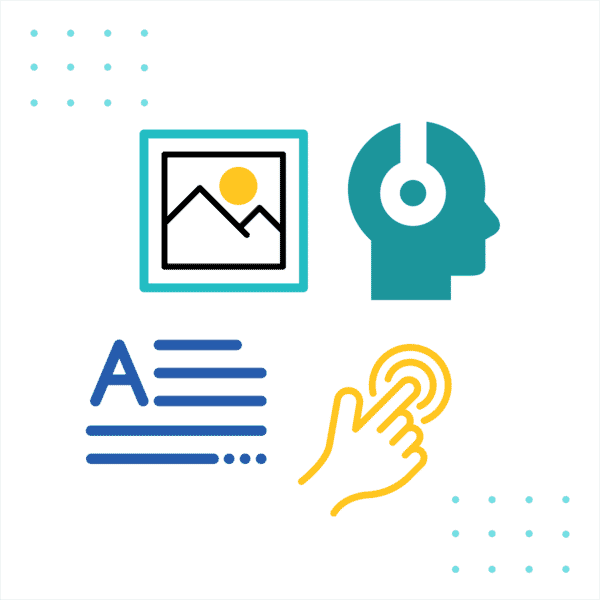This guest blog post was written by Dr. David Marshall, a technical writer and a training developer since 2007. He is also the owner of Neithdos Consulting Services LLC. Dr. Marshall received his DM in Executive Leadership from Colorado Technical University in 2021.
Have you ever tried teaching an important topic to someone only to see the glazed look in their eyes? Have you ever been in a classroom or attended an online training session only to be confused about what the presentation is about? One of the reasons why the student in the classroom or the attendee at a trainee session or in the Zoom call was not able to understand the topic could be due to the delivery of the learning material. How can instructors avoid this dilemma? Through multimodal learning.
Definition of Multimodal Learning
Multimodal learning is a concept where the teacher, instructor, or presenter will demonstrate the learning material using multiple methods at the same time. This method is effective due to the diverse methods of learning styles. According to research from the Gordon Kelley Academic Success Center, students who are exposed to multiple learning styles can learn the material quicker and have a deeper understanding of what was taught within the learning process, while retaining more of the information.
There are four examples of multimodal learning:
- Case-Based Learning: Using real-life examples.
- Multimedia Research Projects: Often used in eLearning software, students find information and create their presentations using different media sources such as books, podcasts, and news clips. For those looking to enhance these projects, a practical guide on how to create engaging eLearning content can provide additional insights into utilizing various media effectively.
- Educational Games: These activities use many modes at once. For example, Prodigy Math: Kids Game uses different modes to make math more exciting to learn traditional mathematics.
- Think-Pair-Share Strategy: A collaborative learning technique used to promote individual thinking, collaboration, and presentation of an activity.
Different Learning Styles of Multimodal Learning
The different learning styles of multimodal learning include:
- Speech
- Audio
- Written/Print
- Illustrations
These learning styles are used on most online learning platforms. However, to be better as a presenter and to engage students across various learning environments, it is important to understand the principles of multimodal learning and implement blended learning techniques. A popular method of explaining every different learning style is through the VARK model.
VARK Model
The VARK model is a popular method created by Neil Fleming, a New Zealand Teacher in the 1970s, to explain the different learning styles. This model describes the four types of learners: visual, auditory, reading/writing, and kinesthetic:
- Visual: Visual learners retain information best by seeing. Visual learning includes pictures and graphs.
- Auditory: Learners who excel through auditory learning, such as listening to audiobooks and podcasts. This style engages multiple senses, including hearing, to enhance memory and understanding.
- Reading/Writing: Learn best by reading and writing. This method integrates traditional and digital learning tools, where writing down the information helps with remembering and appeals to those who prefer a text-based approach.
- Kinesthetic: Learners thrive with hands-on activities that deepen their learning experience and promote deep learning by allowing them to engage directly with the material.
Using the VARK model, students performed better because the diverse learning styles that were used matched their specific learning style.
How is Multimodal Learning Important?
According to research, students learn best when educators apply multiple learning styles simultaneously or in other words using multimodal learning. Multimodal Learning creates an environment where students are excited to learn which increases engagement. In today’s environment where digital learning and technology are used more than ever in the classroom, a multimodal learning environment is created through the use of videos, high-quality audio, and whiteboard animation. There has been a growing trend in digital learning and training even before the pandemic forced everyone to work or attend school in a virtual or hybrid environment. This trend opened the opportunity for educators and instructors to innovate, finding a way of teaching through the use of technologies and multimedia resources.
Conclusion
Our goal as an educator is to make sure that the students or attendees fully comprehend the material that is being presented. Using the multimodal learning strategy will ensure that each individual benefits from the teaching a rich multimodal learning experience and apply it either in their personal or professional life.
MadCap Software enhance this endeavor by providing advanced tools that cater to diverse learning needs. MadCap Flare provides robust content authoring and publishing tools perfect for creating accessible educational materials for various learning styles.
Xyleme distinguishes itself as an enterprise-level Learning Content Management System (LCMS), ideal for larger organizations needing to manage and deliver complex multimedia content effectively. Its centralized content management system simplifies the distribution and analysis of educational programs, making it an indispensable tool.
MadCap ensures educational content is not only engaging but also broadly accessible, meeting the needs of today’s diverse learning environments and the demands of the rapidly evolving global education landscape.










